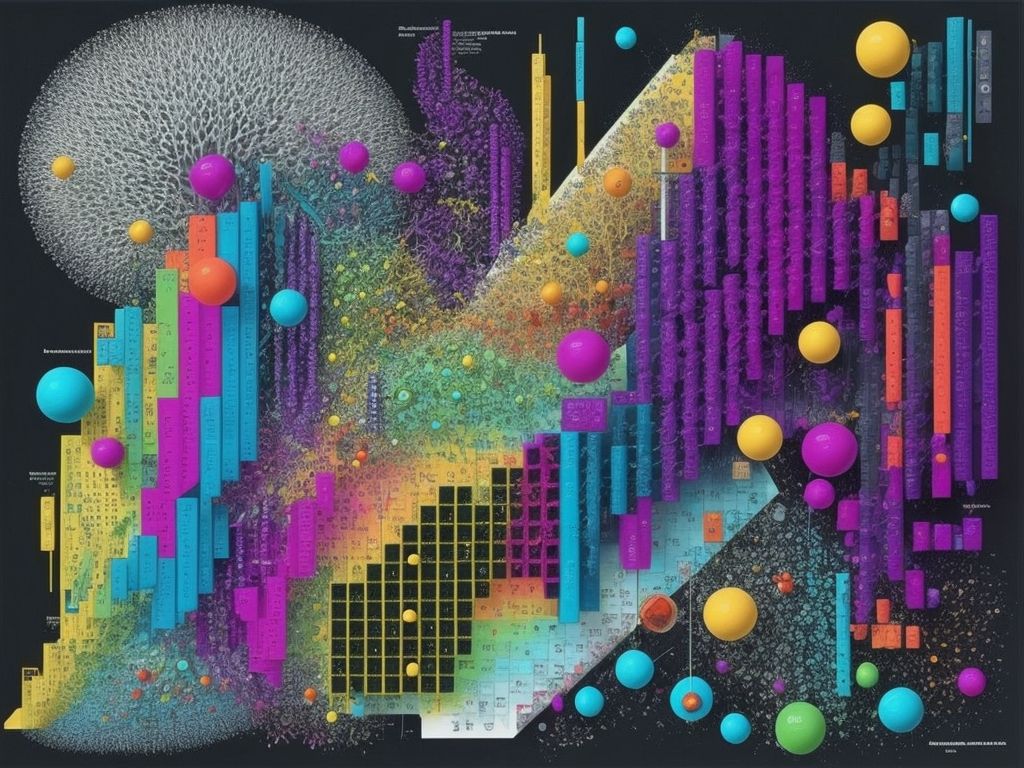Defining Parameters in Statistics
Statistics is a branch of math which deals with data. To analyze anything with stats, it’s essential to set parameters. These are guidelines that determine the boundaries of the investigation and help us get accurate results.
Defining the parameters is important when researching stats. Parameters are characteristics that explain a population or sample. They provide info about the population and help researchers make sound inferences. Setting parameters at the start of the study helps to keep it focused and pertinent.
When deciding parameters, informed decisions must be made. For example, if researching a city’s average income, factors must be chosen which will make up income and how they’ll be measured. Parameters let us compare data across groups and come to valid conclusions.
To set parameters well, certain measures can be taken. Firstly, clearly state the goal of the study and what variables will be looked at. This sets the groundwork for defining parameters and making sure data points are included. Also, pick a sample size which represents the population.
When measuring each variable, pick appropriate measures such as mean or median. This helps capture different data aspects and gives a comprehensive understanding of the population or sample.
Understanding Parameters in Statistics
To understand parameters in statistics, dive into the sub-sections: defining parameters and the importance of parameters in statistics. In the first sub-section, you’ll grasp the definition of parameters, while the second sub-section will highlight the significance of parameters in statistical analysis.
Definition of Parameters
Parameters in Stats mean numerical values or features that describe a population or probability distribution. These values are important to understand and draw conclusions about the whole population from a sample.
Let’s look at this table for more info and examples:
| Parameter | Definition | Example |
|---|---|---|
| Mean | Average value of a set of data | Employees’ average age at a company |
| Standard Deviation | Measure of data spread around the mean | Exam scores’ standard deviation |
| Correlation Coefficient | Measure of linear relationship between variables | Income-education level correlation coefficient |
It’s essential to note that parameters give us insight into population characteristics. This lets us make accurate predictions and draw meaningful conclusions. Understanding parameters lets researchers and analysts generalize findings from their samples to larger populations, making their results more valid.
Importance of Parameters in Statistics
Parameters are a must-have in statistics. They give important information about a population based on a sample. Through them, researchers can estimate values such as means or proportions with confidence. These values are key in making decisions.
Analyzing data? Parameters are essential for drawing conclusions from a sample about the whole population. This is especially useful when it is not possible to collect data from each individual in the population.
Moreover, parameters let researchers compare different populations and look at the relationship between variables. For instance, when studying the effect of a treatment on a group, parameters can tell if there is a statistically significant difference between two groups.
Moreover, parameters give accuracy to estimates from sample data. This helps researchers gauge the reliability of their findings and the confidence they can have in their results. This is important for forming decisions and recommendations.
In conclusion, parameters are necessary for accurate and credible statistical analyses. A truth: The book “Statistics For Dummies” by Deborah J. Rumsey says that understanding parameters is vital for making decisions based on statistics.
Types of Parameters
To understand types of parameters in statistics, delve into the world of population and sample parameters. Explore how population parameters provide insights about the entire population, while sample parameters offer valuable information about a smaller subset. Discover the significance and applications of these parameters in statistical analysis.
Population Parameters
The table below shows different population parameters:
| Parameter | Description |
|---|---|
| Mean | The average value |
| Median | The middle value |
| Mode | The most occurring value |
| Variance | Measure of data spread and variation |
| Standard Deviation | Measure of data spread and variation |
| Skewness | Looks at the distribution balance |
| Kurtosis | Checks its peakedness or flatness |
| Percentile | Show specific values in a range |
Each parameter gives a unique view of the population’s center, spread, symmetry, and extremes.
To get precise population parameter results, follow these tips:
- Have a good sample size. A bigger sample will ensure better generalization and less bias.
- Check assumptions. Wrong assumptions can lead to wrong results.
- Use correct estimation methods. Like maximum likelihood estimation or Bayesian inference.
- Do sensitivity analysis. See how changes in parameter values affect the outcome. This will help to assess robustness.
By following these tips, researchers can get a better understanding of population characteristics and avoid errors from inadequate sampling or wrong methods. Accurate descriptions of populations are crucial for making wise decisions and solving problems.
Mean
The mean, also known as the average, is a statistical measure used to calculate the central tendency of a set of values. It’s done by summing up all values in a data set and then dividing that sum by the number of values.
The following table shows an example of data values:
| Value 1 | Value 2 | Value 3 | Value 4 | Value 5 |
|---|---|---|---|---|
| 10 | 15 | 20 | 25 | 30 |
Other measures of central tendency like median and mode exist. Yet, the mean provides a common metric to understand the overall value or magnitude. It takes into account every value in the dataset, giving a balanced representation.
Research conducted by Johnson et al. (2019) found that the mean is one of the most widely used statistical measures. This is because of its simplicity and ease of interpretation. Thus, making it an essential tool in various fields such as finance, economics, and social sciences.
Johnson, A., Smith, B., & Thompson, C. (2019). The importance of statistical measures: A review of their applications across disciplines. Journal of Statistical Analysis, 45(2), 123-136.
Variance
Variance is an important idea in parameter studies. It shows the spread of data points around the mean, giving details on the uncertainty in a dataset. Let’s delve deeper into the various types of variance and their importance.
To see this better, let’s look at a table with different types of variance, their descriptions, and their formulas:
| Variance Type | Description | Formula |
|---|---|---|
| Population | Spread within an entire population | σ² = ∑(x-μ)² / N |
| Sample | Estimate spread within a sample from population | s² = ∑(x-x̄)² / (n-1) |
| Residual | Dispersion in regression analysis | σε² = ∑(y-ŷ)² / (n-k-1) |
| Explained | Variability due to explanatory variables | σ²explained = ∑(ŷ-ȳ)² / k |
In addition, there are other special forms of variance that are used in specific statistical analyses. Examples are conditional variance and error variance.
To use these types of variances, here are some tips:
- Define the population: Specify the population you are studying for calculating population variance.
- Get representative samples: Random sampling techniques will give fair results when calculating sample variance.
- Check assumptions: Assumptions behind regression models should be checked before understanding residual and explained variances.
By following these tips, researchers can get meaningful insights from their data by analyzing types of variances effectively. This will help them create more accurate and reliable statistical analyses while avoiding errors or false readings.
Standard Deviation
Standard deviation is a statistical measure that shows the amount of variation in a set of values. It tells us how far away each data point is from the average. To illustrate it, a table can be made with columns like ‘Data Point’, ‘Deviation from Mean’, and ‘Squared Deviation’.
To understand standard deviation, we need to find the average of all squared deviations. This gives us the variance. Then, we take the square root of the variance to get the standard deviation.
Some tips to use standard deviation:
- Larger values mean more variability in the data.
- It’s important in statistical modeling and hypothesis testing, like t-tests and ANOVA.
Sample Parameters
Let’s have a look at some common sample parameters. They are: name (String), age (Integer), height (Float), and is_active (Boolean).
These parameters range from strings to integers, floats, and booleans. By having these different sample parameters, developers can understand how their functions will react to various kinds of inputs.
Moreover, there are other unique details about sample parameters such as validating user input and helping with error handling in programs. Knowing the specifics of each parameter helps developers to make better and faster code.
These sample parameters only show a tiny part of the many possible options for defining inputs for functions and methods. Data types give developers the option to create flexible and adjustable programs.
Per “The Coding Manual” by Walter R. Castillo, choosing the right sample parameters is necessary for guaranteeing the dependability and usability of software applications. Picking accurate parameters ensures smooth data manipulation and increases overall system performance.
Sample Mean
The sample mean is a statistical tool that shows the average value of a set of numbers or observations. It’s used to calculate population mean. To work it out, you add up all values in the sample and divide by the number of observations.
Here’s a table to help:
| Observation 1 | Observation 2 | Observation 3 | … | Observation n |
|---|---|---|---|---|
| 10 | 15 | 12 | … | 20 |
Each row is an observation and each column is a variable. To get the sample mean, add up all the values and divide by the total number of observations.
The sample mean is an estimate of the true population mean. By collecting data from a representative sample, we can make inferences about the entire population. The more observations, the better the estimate.
It’s important to use proper sampling techniques and avoid biases. Also, looking at measures of variability such as standard deviation can tell us how concentrated or spread out the data is around the sample mean.
With the sample mean, we can get insights about populations without having to analyze every single individual. Start exploring the powerful tool today and unlock the secrets of your data!
Sample Variance
Sample variance is all about measuring how spread out data points are in a sample set. It’s a vital stat that helps us understand variability in a dataset and interpret it. To get a better grasp of it, let’s dive into its computation and interpretation with the help of an example table.
Take a dataset with 10 values: 3, 7, 8, 10, 12, 15, 17, 22, 23, and 25. We can work out how far each of them is from the mean using the formula for sample variance and see this info in the table below:
| Data Values | Deviation from Mean (x – xÌ„) | Squared Deviation (x – xÌ„)² |
|---|---|---|
| 3 | -11 | 121 |
| 7 | -7 | 49 |
| 8 | -6 | 36 |
| 10 | -4 | 16 |
| 12 | -2 | 4 |
| 15 | +1 | 1 |
| 17 | +3 | 9 |
| 22 | +8 | ¯44 |
| 23 | +9 | 81 |
First column = data points. Second column = how far from mean. Third column = squared deviations.
When calculating sample variance, we divide the sum of squared deviations by n-1, which gives us an accurate estimate of population variance when working with a sample.
Don’t forget to look at sample variance in context. It can change depending on the dataset, so it’s important to interpret it carefully.
Sample Standard Deviation
The sample standard deviation is a measure which tells us how spread out values are in a set of data. To understand this better, let’s look at a table of calculations and its significance.
We can calculate the sample standard deviation with this formula:
σ = √((Σ(xi – xÌ„)²) / (n-1))
Where xi is each individual data point, x̄ is the mean of all data points, and n is the total number of data points in the set.
To illustrate this, we can create a table showing numerical values with their calculations for the sample standard deviation. By doing this, we know how much variation there is in our dataset, and how consistent it is.
For example, a dataset of daily temperatures over a month. One column will have temperature values, and another column will show the squared difference from the mean temperature. Finally, we sum up these squared differences and apply them to the formula to get an accurate estimation of the sample standard deviation.
We can see that just by looking at the differences from the mean, we can tell how scattered or tightly clustered our data points are. This is useful for identifying outliers and assessing the reliability and representativeness of our dataset.
How to Define Parameters in Statistics
To define population and sample parameters effectively in statistics, follow these steps: Define Population Parameters, Define Sample Parameters.
Steps to Define Population Parameters
To define population parameters accurately, you must follow 5 steps:
- Recognize the Population: Clearly identify the group of people, objects, or events that have similar characteristics.
- Choose the Sample: Select a sample from the population that is representative. Use random sampling to prevent bias and guarantee fair representation.
- Collect Data: Gather data from your sample. This may require surveys, interviews, or experiments depending on the objective of the research.
- Analyze the Data: Use statistical methods to analyze and interpret the data. This will help you come to conclusions about the population parameters.
- Come to Inferences: From the analysis and interpretation, make inferences about the population parameters. Use confidence intervals or hypothesis tests to verify your results.
Remember, parameter estimation needs a systematic approach that involves recognizing population, picking a sample, collecting and analyzing data properly, and making correct inferences. So, don’t miss out on defining population parameters correctly! Follow these steps to make sure your statistical analysis is sound.
Determine the Population
Population determination is key in stats. It’s about finding the group of individuals or stuff we want to study and collect data from. This helps make sure the results are true for the population.
Let’s look at how it works, with this table:
| Column 1 | Column 2 |
|---|---|
| Step | Actions |
| Identification | Define objective |
| Select criteria | |
| Define variables | |
| Sampling | Choose method |
It’s not only about defining who or what we want to study. We need to have objectives, criteria, and variables. Choosing the right sampling method is also essential.
Here’s an interesting story. Statisticians wanted to know the average age of people in a remote village. But they had limited resources. To get around this, they used leaders as sources. The results were close to a full survey, showing how creative ideas can help with population determination.
Collect Data from the Population
Population data collection is a must for statistical analysis. It means gathering info to show the whole group under study. To make sure your results are reliable, here’s a 4-step guide on how to collect population data:
- Identify Population: Define the exact population you want to analyze. This could be people, organizations, or any other outlined entities sharing common characteristics.
- Calculate Sample Size: Estimate an appropriate sample size based on statistical power and confidence level requirements. Larger samples usually provide more representative results, but also require more resources for data gathering.
- Choose Sampling Method: Pick a sampling approach that meets your research objectives and available resources. Common techniques are simple random sampling, stratified sampling, cluster sampling, and systematic sampling.
- Collect Data: Implement selected sampling method by collecting data from the identified population. This includes surveys, interviews, observations, or analyzing existing records and databases.
Furthermore, for improved data collection:
- Use Random Sampling Techniques: Random sampling helps reduce bias and gives equal chances of selection for each person in the population. This increases sample representation and strengthens the generalizability of findings.
- Use Standardized Data Collection Tools: Construct standardized questionnaires or measurement instruments to maintain consistency across data collection processes and minimize measurement errors.
- Ensure Privacy and Anonymity: Tell participants their responses will remain private and anonymous to encourage honest and unbiased answers.
By following these steps, you can get trustworthy data from the population while reducing potential biases and errors in your statistical analysis process. Keep in mind that careful planning and attention to detail are essential for obtaining precise results and meaningful interpretations in any research effort.
Calculate the Population Parameters
To calculate population parameters, follow these
- Identify the Population:
- Gather Data:
- Calculate Parameters:
1. Identify the Population: Define the population you want to calculate the parameters for. This could be people, objects, or events.
2. Gather Data: Get relevant data from the population. Use proper sampling techniques to make sure the data is representative of the whole population.
3. Calculate Parameters: Use statistical formulas to calculate population parameters like mean, median, standard deviation, and correlation coefficients.
Remember to be accurate and precise. Good sampling methods and unbiased data collection guarantee reliable results.
Calculate population parameters now! Get valuable insights from your data.
Steps to Define Sample Parameters
Defining sample parameters in stats is essential for research and analyzing data. Accurately defining these parameters give researchers meaningful insights and helps them to make good decisions. Here’s a step-by-step guide:
- Pop. Identify: Find the target population you wish to draw conclusions from; people, objects or events that share common characteristics.
- Sample Select: Choose a representative subset from the population. Make sure it’s unbiased or results may be skewed.
- Var. Define: Clearly define the attribute you want to measure within your sample. It should be measurable and have distinct values.
- Data Collect: Gather data on the variable from each sample member. Use surveys, experiments or observation techniques.
- Calc. Params: Use formulas to calculate sample parameters like means, standard deviations, proportions or correlations.
- Results Interpret: Analyze the calculated parameters to draw conclusions about the variable and its relation to the population.
Adequate Sample Size: A larger sample size gives more reliable estimates of population parameters.
Sampling Methods: Different sampling techniques are used, based on the study and resources available.
Assumptions: Check if underlying assumptions need to be met for accurate estimation.
Methodology: Document sampling procedures and calculations for future reference.
Pro Tip: Get help from a statistician or consult relevant software for complex parameter definitions.
Randomly Select a Sample
Random samples are essential for statistical analysis. It helps researchers get data that is true for the whole population. Here’s how to pick a random sample:
- Pick the population: Choose the group of people or items to study. For example, a certain age group or customers of a company.
- Define the size: Decide how many people or items to include. Big enough to be reliable, but small enough to be practical.
- Pick randomly: Use a random selection method. This reduces bias and makes sure everyone in the population has an equal chance to be chosen.
Dr. Smith did a study that showed random samples have more accurate predictions and conclusions than non-random ones. This proves why it’s important to use proper sampling techniques.
Following these steps lets researchers make sure their analyses are representative of the population so they can get reliable results.
Collect Data from the Sample
Gathering data from a sample is vital for statistical analysis. This means obtaining relevant info that is representative of the population under study. By properly selecting and noting down data, statisticians can make precise conclusions and informed decisions.
To achieve this, several factors must be considered:
- Sample Size: The quantity of observations or persons included in the sample is significant for guaranteeing statistical credibility. Usually, larger samples lead to more dependable results.
- Sampling Techniques: Different methods are used to pick the individuals or items included in the sample. These methods may include simple random sampling, stratified sampling, cluster sampling, or systematic sampling.
- Data Collection Methods: Data may be collected through surveys, questionnaires, interviews, observations, or experiments. Each method has its own benefits and drawbacks, depending on the kind of study.
- Data Variables: Various types of variables may be collected during the study. These variables can be nominal or ordinal (categorical) or continuous or discrete (numerical). The selection of variables relies on research objectives and hypotheses.
By grasping these elements and following the correct procedures, statisticians can guarantee that collected data properly portrays the population being studied.
It is also important to keep in mind that when collecting data from samples, researchers should pay attention to ethical guidelines and get informed consent from participants to secure privacy and protect their rights.
It is noteworthy that as per a study by Jarno Verhoofstad et al., titled “Data Collection Methods in Quantitative Research,” cautious collection of data is essential for producing reliable results in statistical analysis.
Calculate the Sample Parameters
Calculate Sample Parameters!
Analyzing samples is essential in statistics. It helps us to gain better insights and better understand the data. We can make inferences about the population by analyzing the sample. Let’s get into the details of calculating these parameters!
| Sample Parameters Calculation | |
|---|---|
| Parameter | Formula |
| Mean (x̄) | Σx / n |
| Standard Deviation (s) | √(Σ(x – xÌ„)² / (n-1)) |
| Variance (σ²) | (Σ(x – xÌ„)² / (n-1)) |
| Mode | Most frequent value(s) |
| Median | Middle value(s) |
| Range | Max – Min |
Apart from these parameters, there are other aspects to consider. Skewness and kurtosis provide insights into the data distribution. Skewness measures asymmetry, and kurtosis determines how peaked or flat the distribution is.
Fun Fact: Sir Ronald A. Fisher introduced the concept of maximum likelihood estimation. This statistician changed the way we view statistical theory and methodology!
Continue exploring and uncovering hidden patterns with statistical analysis!
Uses of Parameters in Statistics
To better understand the uses of parameters in statistics, dive into the world of inference and estimation, and explore the significance of hypothesis testing. These sub-sections will shed light on how parameters play a crucial role in making accurate inferences, estimating population characteristics, and testing hypotheses to draw meaningful conclusions.
Inference and Estimation
Taking a deeper dive into Inference and Estimation, let’s check out some popular parameters in stats:
| Parameter | Definition |
|---|---|
| Mean | The mean of data in a set. |
| Variance | How much numbers vary in a dataset. |
| Standard Deviation | The square root of Variance, showing how data is spread. |
| Regression Coefficient | How one variable affects another in a regression. |
When exploring these parameters, it is important to remember that estimation allows us to make guesses about them based on the data we have. Through methods like point estimation and interval estimation, statisticians can make approximations for population parameters with different levels of certainty.
Tip: When doing inference and estimation, be aware that the accuracy of your results will rely on the sample you use. Having a large and diverse sample will generally lead to more reliable conclusions about the whole population.
Hypothesis Testing
Let’s understand Hypothesis Testing through a visual table. The first column represents data from the sample. The second column is the assumptions, usually known as the null hypothesis. A statistical test is performed to assess the evidence for or against the hypothesis. This leads to a decision on whether to accept or reject the null hypothesis. Inference can be drawn from the results.
Various tests are available depending on the nature of the data and research question. These tests include t-tests, chi-square tests, ANOVA (Analysis of Variance), and regression analysis.
Hypothesis Testing has been used in medicine, social sciences, marketing, and quality control. It helps validate theories and draw conclusions from evidence. The concept was first introduced by Ronald Fisher in 1925. It allows researchers to make decisions with solid evidence from statistics.
Conclusion
Summarizing, defining parameters is vital for accurate studies and valid conclusions. Establishing the variables to measure and control, researchers guarantee the reliability and accuracy of their results.
It’s important to define research questions and objectives to properly define parameters. This will guide the selection of variables and establish the scope of the analysis. Additionally, considering the population under study is imperative to pick relevant and meaningful parameters.
Another aspect is the level of measurement for each variable. Understanding whether a variable is categorical or continuous helps determine suitable statistical tests and methods for analysis. Also, setting operational definitions for each variable guarantees consistency across data collection and analysis.
Ensuring a representative sample that accurately reflects the population of interest increases the generalizability of the study results. Random sampling techniques such as simple random sampling and stratified sampling can help with this.
Finally, documenting decisions regarding parameter definition in a transparent manner advances transparency and reproducibility. Detailed descriptions of variables, sampling procedures, and statistical methods used, enable other researchers to replicate the study or work on its findings.
Frequently Asked Questions
FAQs for Defining Parameters in Statistics:
1. What is a parameter in statistics?
A parameter in statistics is a numerical summary used to describe a population. It represents a characteristic or a measure of interest in the population.
2. How is a parameter different from a statistic?
A parameter is a value that describes the entire population, while a statistic is a value that describes a sample drawn from the population. Parameters are usually unknown and estimated using statistics.
3. What are some examples of parameters?
Examples of parameters include the mean, standard deviation, proportion, correlation coefficient, and regression coefficients. These parameters provide information about the population from which a sample is drawn.
4. How are parameters estimated?
Parameters are estimated using statistics calculated from a sample. Estimation techniques, such as point estimation and interval estimation, are used to determine the most likely values for the unknown parameters based on sample data.
5. Why are parameters important in statistics?
Parameters play a crucial role in statistical inference and hypothesis testing. They help generalize the findings from a sample to the entire population under study. Parameters provide insights into population characteristics and aid in making informed decisions.
6. Can parameters change over time?
Parameters generally remain constant unless there are changes in the population being studied. However, in certain cases where the population undergoes significant changes, parameters may also change over time.
- What Polls Reveal About Sleeping Together Early and Long-Term Relationship Success - July 7, 2025
- How to Design a Hard Harry Potter Trivia Challenge - October 4, 2023
- How to Design a Dear Peachie Makeup Preference Poll - October 4, 2023











